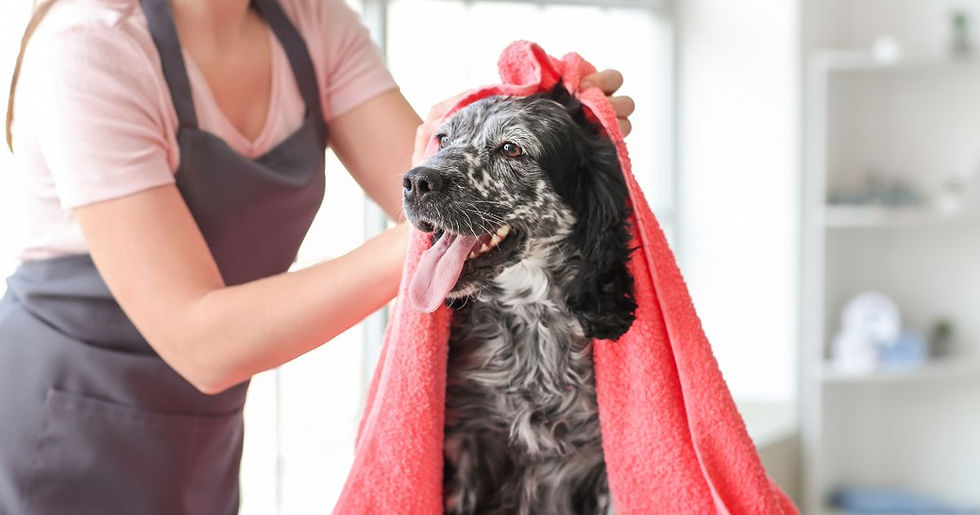What Senior Pets Try to Hide: How Grooming Can Uncover Health Changes
- Dr. Emma Clark

- Aug 25
- 4 min read

As pets age, they often become skilled at masking discomfort and decline. Whether it’s out of instinct, routine, or a stoic personality, many senior dogs and cats quietly adapt to slow, progressive health changes—making it easy for owners to miss subtle warning signs.
Grooming isn’t just about keeping your pet looking tidy; it’s a vital tool for discovering underlying issues hidden beneath the fur. Regular hands-on care offers a unique opportunity to detect early signs of illness that may otherwise go unnoticed—particularly in long-haired or thick-coated breeds.
Contents
Why Grooming Is a Health Check in Disguise
What You Might Miss Under the Fur
Areas to Pay Close Attention To
How to Make Grooming a Meaningful Routine
FAQs
Why Grooming Is a Health Check in Disguise
For older pets, professional or at-home grooming sessions provide more than just a fresh coat—they offer close contact and a chance to assess your pet’s physical condition in detail. Senior pets, especially those with chronic illnesses, may not always display clear symptoms. Grooming allows you to gently uncover concerns that your pet may be trying to hide.
Whether you're brushing, bathing, trimming, or simply running your hands along their body, grooming helps you:
Feel for new lumps or changes in existing ones
Observe muscle tone and overall body condition
Notice areas of discomfort, flinching, or stiffness
Identify skin infections, parasites, or wounds hidden by dense fur
Spot changes in grooming behaviour that could reflect illness or pain
This kind of physical contact becomes more valuable as pets age, when subtle changes can signal significant health developments.
What You Might Miss Under the Fur
Many common age-related issues are easy to overlook without regular tactile checks. Long-haired breeds or pets with dense undercoats are especially likely to hide visible signs of health decline.
Conditions that may go undetected include:
Muscle loss (sarcopenia): Especially in the hips, thighs, and spine. A thick coat can conceal the ‘sunken’ look that signals muscle wasting, often related to arthritis, inactivity, or metabolic disease.
Skin lesions or sores: These might include hot spots, pressure sores, or scabs from excessive licking or scratching. If the coat mats, moisture and bacteria can become trapped against the skin.
New or changing lumps: Benign lipomas, cysts, or more serious tumours may be small and hidden at first, especially if located under dense fur.
Parasites: Fleas, ticks, or lice can be missed unless you’re parting the coat or brushing thoroughly.
Dry, flaky, or irritated skin: Common in older pets due to hormonal changes, nutritional deficiencies, or underlying conditions like hypothyroidism.
Without hands-on contact, these conditions may progress silently until they cause significant discomfort or become harder to treat.
Areas to Pay Close Attention To
When grooming an older pet, pay extra attention to the following high-risk areas—these are spots where hidden problems often first appear:
Spine and hips: Common sites of muscle loss and arthritis-related stiffness. Gently palpate for pain or sensitivity.
Underarms and groin: Warm, less-aerated regions prone to matting, sores, and inflammation.
Neck and chest: Areas where lumps often develop, and where dense fur can trap moisture.
Paws and pads: Check for cracked skin, long nails, or debris lodged between toes. Mobility changes may go unnoticed unless the feet are inspected closely.
Ears and base of tail: Frequent spots for fleas, ear infections, or grooming-related discomfort.
Teeth and gums: While not part of coat grooming, checking the mouth gently during handling is essential. Dental disease is common in seniors and often underdiagnosed.
These regular checks can help spot abnormalities early, ensuring faster diagnosis and treatment.
How to Make Grooming a Meaningful Routine
Grooming a senior pet should always be gentle, patient, and calm. If your pet has painful joints or anxiety about being handled, consider breaking sessions into shorter, more frequent interactions.
Tips for making grooming a health check as well as a bonding experience:
Choose the right tools: Use soft-bristled brushes, wide-toothed combs, and pet-safe grooming aids designed for ageing skin and sensitive joints.
Set a calm environment: Use a quiet room, non-slip mat, and low lighting if needed. Talk softly to reassure your pet throughout.
Watch for reactions: If your pet flinches, pulls away, or licks excessively after you touch a certain area, it could be a sign of pain or discomfort.
Keep notes: Jot down anything unusual you notice—like new lumps, dry patches, or signs of weight loss—and mention them to your vet at the next check-up.
Work grooming into a routine: Weekly or bi-weekly brushing sessions keep your pet comfortable, reduce matting, and allow consistent health monitoring.
If grooming becomes difficult due to mobility or coat condition, a visit to a professional groomer experienced with senior pets can help.
FAQs
My pet’s coat looks fine—do I really need to groom them regularly?
Yes. Even pets with clean or sleek coats benefit from regular tactile checks. Grooming helps you find problems hidden beneath the fur and provides bonding time that supports emotional wellbeing.
How often should I check for lumps or skin issues?
Ideally once a week during grooming. The more frequently you check, the easier it is to spot changes early.
My senior pet dislikes being brushed—what can I do?
Go slowly, use treats and praise, and choose softer tools. Break grooming into short sessions and avoid areas that cause distress until they’ve been assessed for pain or sensitivity.
Can my vet help if I find something unusual during grooming?
Absolutely. Bring any concerns—like new lumps, hair loss, or soreness—to your vet promptly. Early detection is crucial in managing age-related conditions.















